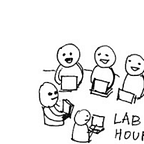Blog post by Liza St. James
Code Words kicked off on Tuesday with a presentation by Milton Läufer. Milton read from his forthcoming book A Noise Such as a Man Might Make as well as various code poems — one of which used the famous microfiction attributed to Hemingway, “For Sale: Baby shoes, never worn” as part of a ‘nano’ program, a program deliberately sized to under 256 bytes. Then Milton took some questions before we launched into student presentations.
Elan Kiderman presented a twitter poem that “grapples with at least several different migrations (1) most immediately obvious, the imagined migration from country to country and (2) from computer to computer. (3) between source texts / perspectives but also (4) the collapsing of many perspectives into a single, limited, monolingual ‘i’. lastly, (4) from text to code back into text.”
Leandra Tejedor presented three works in progress, “the first two are based on different origin stories of devil’s tower in wyoming, the last uses quotes from Close Encounters of the Third Kind. The projects here created in aframe and javascript. The poetry isn’t generative really, as much as I wrote code to create the template of the poem and human-edited it from there.”
Garen Torikian used the prompt to “emphasize…a weird way to wait” to create an interactive poem, of which he explained, “I coded up Space. Rather than scrolling up and down to read the contents of a poem-story, the visitor is required to scroll in every direction in order to gain a complete understanding of the message.”
Elana Sasson presented a poem called “THEY DID THAT ONE TIME AT THAT PLACE,” of which she wrote, “I crafted a series of moments/anecdotes from source material I wrote myself. I see the creation of this poem & my use of code to generate the work as a collaborative process. What resulted was unforeseen narratives and outcomes that felt familiar and unfamiliar, specific and yet detached.”
Our discussions of student works led to some big questions: What does it mean to say a particular code is ugly? Can code be ugly? Can we compare versions of a coded work to artwork in other mediums? Is an early code version to a code poet comparable to a visual artist’s sketch? When and how might a code itself be the poem? Is code more like art or language or mathematics or… Where and how do these analogies and metaphors break down? In our workshops of student work we also discussed various ways in which we all come to a text—where our eye meets the code poem and how that information can be valuable as we continue. We also discussed the ways in which, in code projects, false positives can give a work texture. We heard jazz coming in from the courtyard as we finished student presentations and took a quick break.
After the break, with the band at the neighboring jazz school still going strong, Milton sat down and said, “We’ve talked about a lot of things here so far, but we haven’t really talked about literature.” He paused and then added, “And if someone tries to tell you what literature is, you should run away from that person.” After some laughter he read a bit from Roland Barthes’ “The Death of the Author,” and said, “If you’re a writer, theoretically you’re supposed to like writing” as he wrote two mathematical sets on the whiteboard. One was an extensional definition (enumerating every element, or word, of the set) and the other was an intensional definition (stating an explicit rule to create the set), and Milton explained that he liked to think of code as intensional. We discussed this for a bit and took time for questions before Milton joked, “we should probably close the door, we’ve got a jazz band in here.”
Milton then discussed the Oulipo in order to reference the various ways constraints have been used to spark creativity in the past, and the ways in which we can build upon those ideas using code. We returned to his Hemingway-inspired generator to look at the code and to better understand the condensed programming used. Nick explained that one bite is eight bits, or 256 spaces in memory. Then we used a series of Python 3 programs provided by Milton, which pulled words from different sets of words to generate text over time. We were invited to play around with the code ourselves and change the words and the order the sets were pulled from.
Our prompts for Wednesday were to keep exploring with the given codes—changing them as we like—but that any words used had to be four letters or fewer (just below the English language average of 5 letters per word). Milton also shared with us the text conflation code he used for A Noise Such as a Man Might Make (which combines The Road and The Old Man and the Sea), saying that we could conflate two texts but that, of course, we’d need a rationale.
